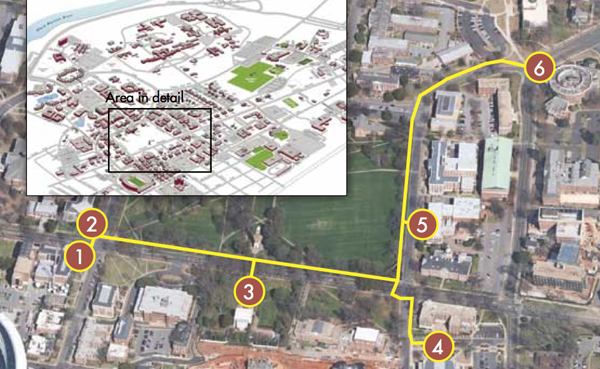During the month of February and other times throughout the year, a UA associate professor leads African American Heritage tours across campus, commemorating the various sites on UA’s campus where many events in the civil right’s movement transpired.
Jason Black, a professor in the department of communication studies, said the idea for this tour came out of his first semester on campus in the fall of 2005 when he taught an African American rhetoric course.
“We’re situated here at the crucible of the civil rights movement and a ton of race-related events,” Black said. “For all that history and context, I noticed my students didn’t know much about Alabama’s contribution and certainly not on campus, and, as a newcomer to the University, I didn’t either.”
After reading “The Schoolhouse Door,” a book written by Culpepper Clark, a former dean to the College of Communication and Information Sciences, Black said he began to determine some key sites on campus that contributed to Alabama’s overall civil right’s effort.
“The tour really originated out of the African American rhetoric class with student interest and we as a group gathered information and put it into a tour,” he said. “In the fall of 2007, I piloted the first legit tour.”
Black said the original tradition was for him to give a tour once a semester, but when word spread among students and faculty, his tour schedule drastically expanded.
(See also “Radical change: One of first black UA students dies at age 70”)
Currently, he gives one tour every fall semester and every Wednesday in February at noon. Outside of these certain dates, Black said he probably gives between eight to 10 additional tours a semester.
“Before I knew it, I was doing them for student recruitment, alumni and as an annual part of black history month,” he said. “It used to last around 30 minutes, but as I’ve continued to learn more details, I include them, so the tour is now up to an hour to an hour and a half.”
Black said it’s important to give tours like this because it memorializes such a foundational moment in time where our campus was right in the dead center of it all.
“On a macro level, it’s important because of the role that civil rights played in our country and also in our region,” he said. “A university is about a marketplace of ideas where people come to discuss issues, especially at a public university which is designed for the people.”
He explained how UA students and faculty literally sit on history in so many ways and why it’s significant to reflect on it.
“These sites are really important and can be used to think back and remember,” Black said. “To stand on the very space where something as big as desegregation on campus happened, to feel the ghost of the past pulse through your system – we sit on history in so many ways.”
There are six stops along the tour, including Reese Phifer and Bibb Graves where protests occurred against Autherine Lucy’s enrollment to the University, the President’s mansion where slave quarter evidence exists, Foster Auditorium where Governor George Wallace blocked the entrance of African American students, Nott Hall, the site of a possible eugenics lab and, finally, slave graves commemorated in 2004 on University grounds.
“If you focus on just the bad stuff and go on a tour like this and see where black students were turned away by a disgustingly racist governor, you feel suffocated by it all,” Black said. “You have to balance the good and the bad so you remember the past, but don’t dwell in it.”
One student, David Dent, a junior majoring in business management, said as a student originally from the North, this tour seems like a great way to expand his knowledge of Alabama history in a unique way.
“I believe every student can get something out of this experience,” Dent said. “This definitely beats a history lesson out of a textbook.”
Lauren Powell, a junior majoring in advertising from Andalusia, Ala., agreed commemorating these events was a good idea for students.
“Recognizing African American achievements and celebrating Black History month should not just be for elementary school children,” Powell said. “We, as University students, should continue to learn about or even be reminded of the difficulties African American students faced and this tour helps illustrate defining moments of our school’s history.”
For those with limited mobility interested in participating in a tour, Black said he is always willing to give a driving tour and to contact him via [email protected].
Leading in today’s Crimson White:
Parking changes to address overflow








